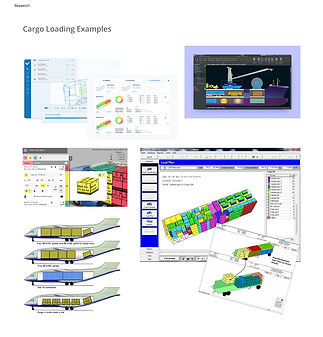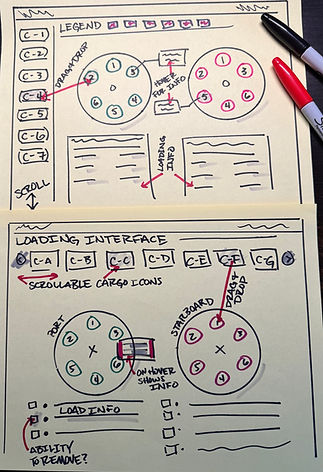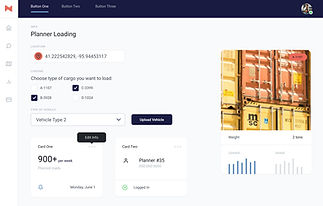Cargo Loading Interface
Redesign a cross-platform logistics interface that helps planning personnel manage cargo loading, optimize space usage, and streamline real-time handling coordination.
Please note: Due to the nature of this project being a government contract, only limited information and visuals can be shared in accordance with security and confidentiality requirements.
Quick Information
Role
Lead UX Designer
Process
Discovery & research
Ideation
Redesign
Final Takeaway
Tools
Figma/Figjam
Adobe Xd
Teams
MS Office

Goal
Design a modern, logistics interface that enables planning personnel to efficiently manage cargo loading operations, maximize available storage space, and coordinate real-time handling across teams and locations.
Problem
Current users rely on an outdated and unintuitive interface, which presents a steep learning curve for new personnel and frustrates experienced planners. The manual entry process for managing field-based transfer lists is time-consuming and error-prone, often resulting in delays, miscommunication, and inefficient space utilization.
Solution
Develop an intuitive, visually-driven drag-and-drop interface that simplifies cargo organization while providing real-time feedback and validation. The new system will significantly reduce manual data entry, improve usability for both new and experienced users, and support faster, more accurate decision-making in high-paced logistics environments.
Discovery & Research
Objectives:
-
Understand workflows of planners and other relevant personnel.
-
Identify bottlenecks to planners based on real user input.
-
Align digital tool functionality with real-world constraints.
Activities:
-
Onsite observations with 2 logistics planners
-
Workflow mapping from cargo intake to cargo final check
-
Pain point identification of current guidance through application and table-based planning layouts
Key Insights:
-
Manual inputs (entering long character strings) cause frequent errors and inefficiencies.
-
Open spaces in cargo area leads to incorrect loading/unloading feedback.
-
Real-time updates are miscommunicated to teams due to labeling.
-
Users need a visual, drag-and-drop interface to simulate cargo loading and planning.


Define, Sketch, & Ideate
Feature Prioritization:
-
Visual layout of cargo bay with clear labeling
-
Drag-and-drop cargo placement
-
Visual suggestions for specific cargo restrictions
-
Shared loading alerts for up-to-date information
Activities:
-
Sketching sessions to map workflows from intake → plan → load → manifest review
-
Designed low-fi wireframes for:
-
Cargo intake screen
-
Load planner with drag-drop interface
-
Interaction indicators and labels
-
Reports and manifest print selection modal
-
Interaction Concepts:
-
Scale-based bay view of containers
-
Auto-calculating center of gravity/weight balance
-
Real-time “loading status” indicators shared to all roles
Wireframe & Prototype
Outputs:
-
Wireframes:
-
Layouts for multiple different cargo bay configurations
-
Color coding and labels for various types of cargo and cargo seating
-
Drag-and-drop walk through with each stage in process clearly defined
-
Early Validation:
-
Drag-drop needed larger interactive targets
-
Color codes for cargo types improved accuracy
-
Most planners would like to be able to toggle tooltips and microcontent
Tools:
-
Figma interactive prototypes
-
FigJam for live session mapping with client
-
User feedback via 1:1 on-site sessions


Design System & Dev Handoff
Deliverables:
-
Component library items for planner avatars, cargo tiles, cargo loading zones labeling
-
Documentation and visuals for development reference and artifacts
-
State mapping for cargo status: planned, selected, confirmed, rejected, success
-
Tooltips and example content for planners to expand on
-
Export-ready specs for:
-
Report selection
-
Manifest selection
-
Final Delivered
Outputs:
-
Drag-and-drop cargo layout with corresponding labeling
-
Cargo tagging: success, warning, and error messaging
-
Tooltips with the ability to toggle visibility
-
Cleaner interface with updated theme utilizing latest design system modifications
-
Exportable reports/manifests and (CSV, PDF, print)
Early Feedback:
-
Planning time was reduced
-
Planners reported increased confidence in load accuracy
-
Improved coordination via shared exportable reports/manifests
Next Steps:
-
Implement newer cargo carriers into the system now that there is a solid foundation
-
Expand the drag-and-drop to other sections of the website with the template built
-
Improve on the report/manifest page content to include cargo bay layouts created

